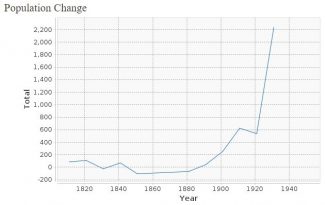The Population Growth of Thundersley Parish



Thanks to the national census results from 1841, much has been known for many years about the large expansion of the population of Thundersley in Victorian times.
The earliest estimate of the population can be made from the Domesday survey of 1086. Thundersley was then a reasonably sized village compared with others in the area, probably partly because its Lord of the Manor was Swein, living at his castle in Rayleigh.
The village then comprised 12 households: 5 villagers, 5 smallholders and 2 slaves. They provided between them the labour required to make use of the 2 village ploughteams and the 2 teams belonging to Swein. Each plough would be steered by one man with another leading the team of oxen.
The estimated household size at that time is between 4 and 5, giving a total in 1086 of between 42 and 52 Thundersley residents.
Recent research of the parish records by Maureen Lennard-Brown, on behalf of AGES Archaeological and Historical Association has enabled a statistical estimate of the post medieval populations to be made from applying the likely birth rate to the number of baptisms recorded for each year.
Applying a formula developed by François Lebrun in 1990, it has been estimated, using the number of baptisms over a 40 year period, that the population of Thundersley in 1665 was 135 and had only risen slightly to 148 by 1785. Around those periods, the population appears to have gone up and down from year to year, perhaps with infectious disease epidemics;
especially affecting the youngest children. Sadly, it was not unusual for families to have to bury a number of children over a short period.
From recent test pit excavations co-ordinated by AGES, it is has been noted that there had not been widespread occupation of the parish before 1800, so the area may then have comprised only isolated farmsteads and hamlets. It is likely that the population rose significantly from 1785 due to improvements in nutrition and medical knowledge. Essentially, fewer children died at a young age and themselves lived long enough to raise their own families.
Pottery dating from 1800 to 1900 has been found all over the parish including the new hamlet of Daws Heath, which is rumoured to have greatly expanded beyond isolated farmsteads with the return of injured sailors and soldiers during the Napoleonic wars (1801 to 1815). The poor financial situation they found themselves in at that time forced them to take up new homes in previously undeveloped areas. It is not known whether such veterans deliberately came to the parish from towns or villages elsewhere, but this seems likely. (Later census records appear to show that very few if any veterans had moved in from outside Essex).
The limited information from the early national census returns in 1801 to 1831 shows the population of the parish rose from 354 in 1801 to 441 in 1811 to 546 in 1821 and dropping slightly to 526 in 1831.
The first widely available detailed national census reveals the situation in 1841, just after the start of the reign of Queen Victoria. By then, 612 people lived in the parish, including 220 in Daws Heath. That appears to be a fourfold increase in the population of Thundersley from the late 1700s.
However, by the time of the 1851 census, the population of Thundersley appears to have fallen back to about 520. By the 1861 census, the number was up again slightly to 531.
The attached graph from www.VisionofBritain.org.uk highlights the growth of Thundersley, particularly after 1900. (This work is based on data provided through www.VisionofBritain.org.uk and uses historical material which is copyright of the Great Britain Historical GIS Project and the University of Portsmouth).
Clearly, more analysis of the Victorian census information is required to check the accuracy of making estimates from the number of baptisms, a topic for ongoing future AGES research.





Comments about this page
Add your own comment
I was interested to come across a reference to the surname of Giggins. My grandmother was a Giggins, although I understand that she came from a bit further west in the county, possibly near Grays. She lived for many years opposite the Bull in Pitsea. Her first name was Rosetta and she had a brother named Arthur. Might she feature in your family tree, Shane?
I’m Shane Michael Giggins great great grandson of John Giggins (Thundersley – Essex) and Susannah Giggins (Prittlewell – Essex) who sailed to Australia in 1844. I want to travel back to my ancestral roots in Thundersley … walk the streets … visit the church that my great great grandparents and three times great grandparents where married in. I want to rub shoulders with the locals and drink a few pints in the local pubs … possibly meet up with some distant relatives … it would be fabulous. We’ve researched our family tree back as far as 1710 and all are from Essex … predominantly Thundersley.
Thank you; my great great grandparents were from here so this is so interesting for me to read. They were all married in a church in Thundersley in the 1800s and came out to Australia in 1844. I would love to find parish records of my Giggins family; please contact me if you can help.
Add a comment about this page